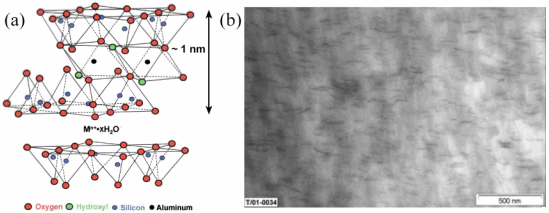Nanoclays in Multi-Functional Composites
Nanoclays are clay minerals optimized for use in clay nanocomposites– multi-functional material systems with several property enhancements targeted for a particular application. Polymer-clay nanocomposites are an especially well-researched class of such materials. Nanoclays are a broad class of naturally occurring inorganic minerals, of which plate-like montmorillonite is the most commonly used in materials applications. Montmorillonite consists of ~ 1 nm thick aluminosilicate layers surface-substituted with metal cations and stacked in ~ 10 µm-sized multilayer stacks (Figure 1a). The stacks can be dispersed in a polymer matrix to form polymer-clay nanocomposite (Figure 1b). Within the nanocomposite, individual nm-thick clay layers are fully separated to form plate-like nanoparticles with very high (nm × µm) aspect ratio. Even at low nanoclay loading (a few weight %), the entire nanocomposite consists of interfacial polymer, with majority of polymer chains residing in close contact with the clay surface. This can dramatically alter properties of a nanocomposite compared to the pure polymer (Table 1). Potential benefits include increased mechanical strength, decreased gas permeability, superior flame-resistance, and even enhanced transparency when dispersed nanoclay plates suppress polymer crystallization.1-4

Figure 1. (a) Schematic of nm-thick montmorillonite clay aluminosilicate layers. (b) TEM micrograph of 2% Nanoclay, Nanomer® I.34TCN — Nylon 6 nanocomposite showing complete dispersion of clay layers into distinct plate-like nanoparticles.
Sigma-Aldrich Materials Science, in collaboration with Nanocor Corporation, is pleased to offer a line of montmorillonite nanoclays. To make the clays compatible with hydrophobic polymers, they are surface exchanged with alkylammonium cations; the five Nanomer® I clays differ in the chemical nature of their surface bound cations. Cationic clay layers of the Nanoclay, Nanomer® PGV (Product No. 682659) are hydrophylic and can be dispersed in aqueous polymers. Nanocomposite properties are highly dependent on the chemical nature of organic cations and polymer chains, as well as the method used to disperse (process) the clay to form the nanocomposite.2 Depending on the polymer to be modified, and the property enhancement you are seeking, we offer product information on our nanoclays below. The table also lists codes to product application datasheets that contain suggestions on how to form nanocomposites. We hope our suggestions will help you. We also hope that having the Nanoclays conveniently available in our catalog will help you explore new methods and applications in this exciting area of materials research.
* Nanomer® clays are products of Nanocor Corporation.
Products
References
如要继续阅读,请登录或创建帐户。
暂无帐户?